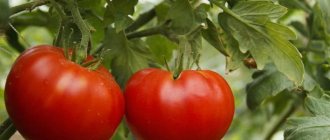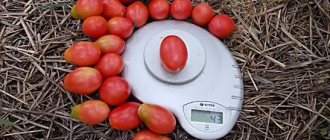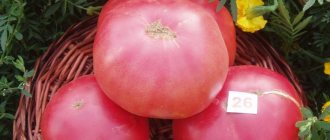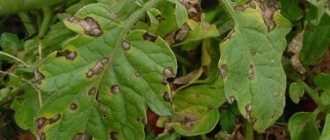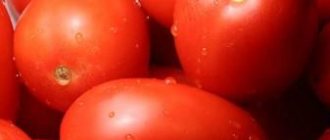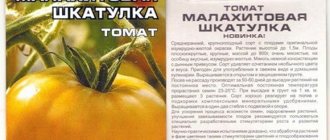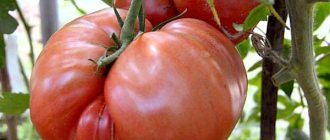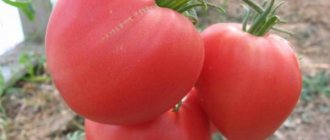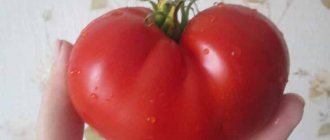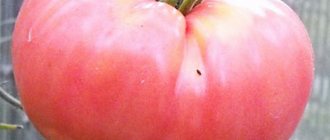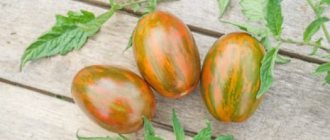Productivity
The Siberian Troika tomato enters the fruiting phase in the middle period - 110...120 days after the sprouts appear. During the season, the bush develops 10...12 fruit clusters, the first one appears after the 9th leaf. Each fruit inflorescence consists of 5...10 flowers.
The yield of the variety (according to the State Register) is 5 kg/bush. The total yield will be 15...20 kg/m2. For a short standard variety with relatively small fruits, this figure is considered high. However, seed producers and gardeners themselves claim that the given figure is underestimated, and up to 25 kg of tomatoes can be harvested from one Siberian Troika bush.
Description and characteristics of the variety
Siberian Troika tomatoes grow in open ground like semi-standard ones. They reach 60 cm and do not need to be formed, especially since they form few stepsons. But the bush seems to be spreading because of the wide-spread long leaves.
Have you already grown the Siberian Troika tomato?
Yes
39.22%
No
60.78%
In greenhouses, tomatoes grow in 2-3 stems, the shoots stretch up to 120 cm. They are thick, strong, but without a garter, under the weight of the fruit they can break or lie on the ground.
The Siberian Troika tomato variety differs from others even at the seedling stage. It is not inclined to stretch, compact, strong, with a thick stem.
The leaves are very large, with narrow segments, widely spaced. If they are not standardized, the bush becomes very thick. They seem clumsy, but this is not a disease or imbalance of nutrients, but a varietal feature.
The first fruit cluster is formed after 6-7 leaves. Subsequent ones - after 2-3 internodes. In total, 5-6 brushes grow on the main shoot. The rest of the harvest is taken from the stepchildren.
This tomato should not be confused with the Troika variety (Russian Troika). They are similar – only the name, even the shape of the fruit is different. Often the negative reviews received by the variety actually refer to the Troika created by the agricultural company Aelita.
Description of fruits
The Siberian Troika tomato, the variety description of which calls for the formation of pepper-shaped fruits, actually produces tomatoes of different sizes. They can be elongated, as in the photo. But often on one bush fruits grow that look like peppers, pears or barrels. Each brush, without standardization, contains from 5 to 10 ovaries.
The taste of the fruit is very good, the color is classic red. Like shape, size can vary greatly. The mass of the lower ones reaches 350 g, length - about 15 cm.
On the upper clusters, the tomatoes gradually become smaller, but they only become too small if there is a complete lack of care and unfavorable weather conditions.
The pulp is dense, but juicy, with a high sugar content, pinkish when cut. There are few seeds.
The first brushes ripen quite quickly, in the mid-early period. But the pouring of the upper fruits is extended. This is not very good for the Siberian regions. When grown in soil, not all tomatoes have time to ripen. But the brown ones can be ripened indoors, and the green ones can be used in winter salads.
The Siberian Troika tomato is suitable for all types of processing. The first tomatoes are not used for whole-fruit canning - they are too large. But the ovaries from the upper clusters, after ripening, fit perfectly into the jar.
The harvest from one bush is 5 kg. For short tomatoes, especially Siberian ones, this is an excellent result.
Pros and cons of the Siberian Troika tomato
The Siberian Troika tomato has a number of advantages, thanks to which it has gained wide popularity.
Among the advantages are:
- excellent taste;
- high yield, stable even in low light;
- resistance to temperature changes;
- resistance to heat;
- disease resistance;
- high commercial qualities;
- versatility of fruit use.
Neither seed producers nor gardeners can identify any significant disadvantages in this variety. Of these disadvantages, we can only highlight the need to tie up the bushes during fruiting.
Who developed this variety of tomato?
The author of the hybrid is a modern businessman and talented breeder Vladimir Nikolaevich Dederko. He works in the city of Novosibirsk and heads agro. Dozens of tomatoes created by this specialist are registered in the State Plant Register.
Among them are those that have already become popular:
- Parsley gardener,
- Oh-la-la,
- Koenigsberg,
- Vasya-cornflower,
- Business lady,
- Superbomb, etc.
Seed producer Siberian Troika - agro An application for variety testing of the Siberian Troika was submitted in 2003. The very next year, the tomato was recognized as a breeding achievement and received permission for cultivation in all regions of Russia.
Interestingly, in the State Register there is another tomato with a similar name - Troika. It was bred agro with the support of the Research Institute of Vegetable Growing in Protected Soil.
There is no one to blame for plagiarism, since applications for registration of these completely different varieties were submitted almost simultaneously - in the fall of 2003.
Description of tomato - Siberian Troika
Siberian Troika is a mid-season variety, the ripening period lasts about 120 days. This is the main drawback and, probably, the only one that Siberians discover. But the problem can be solved by early sowing of seedlings.
The advantage of this is the excellent behavior of the tomato on the windowsill. It does not stretch, the stem is thick from an early age, which is not surprising, because the bush of the Siberian Troika is of a standard type.
Siberian Troika is a standard tomato, the bushes are already strong during the seedling period and do not stretch. Another feature is the emerald large leaves, which do not hang along the stem, but are located almost horizontally, creating the effect of a lush, spreading bush.
Appearance
The Siberian Troika grows up to 60 cm in height, but in a greenhouse it can surprise and shoot out a stem up to 120 cm. In any case, the first brush is laid above the 9th leaf, all subsequent ones - after one or two.
The fruits have a clearly defined pepper-shaped shape: cylindrical with a sharp nose. The first tomatoes grow as long as the palm of your hand - up to 15 cm, weighing 200-350 g, the average weight for this hybrid is 80-100 g.
Characteristics and Application
The size of tomatoes of this variety is suitable for salads and whole-fruit canning. The pulp of the Siberian Troika is thick, fleshy, and the taste of fully ripened tomatoes is sweet. However, vegetable growers have noticed that in rainy and cool summers the fruits lack sugars and can be watery and tasteless.
Siberian Troika tomatoes have a pepper-shaped shape. The yield officially recorded in the State Register is 6 kg/m². The company claims higher productivity - up to 5 kg per plant. However, some gardeners say that this figure is also underestimated.
With good agricultural technology, the Siberian Troika yields up to 25 kg per bush, while one tomato can grow up to 400 g. The advantage of the hybrid is its high resistance to disease.
Tomatoes Siberian Troika
Features of cultivation
In order for the Siberian Troika bushes to show increased productivity, it is necessary to provide them with high-quality care and know a few agrotechnical tricks.
Sowing of seedlings is carried out in the early stages - in late February-early March. You should not be afraid of seedlings stretching due to lack of sunlight; the Siberian Troika practically does not stretch and tolerates low light quite easily. When sowing at a later date, the bushes simply will not have time to set a large number of tassels.
Planting is carried out mainly in open ground, then the seedlings are provided with temporary shelter for the adaptation period. Planting in a greenhouse is also possible - the tomato tolerates heat well (it does not drop flowers and sets fruit normally in extreme conditions). The planting pattern is standard - 50x40 cm. If desired, you can place 2 seedlings in 1 hole.
Care is the most standard. The Siberian troika is so unpretentious that it only needs watering, loosening, weeding and fertilizing. The first three activities can be carried out somewhat less frequently if you mulch the soil in the garden bed.
The formation of bushes is carried out only in their lower part: you need to remove all the shoots located below the first flower brush. The crown that the bush will develop in the upper part does not need to be formed. Despite the fact that the bush has a powerful trunk, you will have to tie up the fruit-bearing branches. Since a lot of tomatoes are set, the branches may break off or sink to the ground, which will lead to their rot.
To increase the yield of the Siberian Troika, you can resort to one simple method - without waiting for the fruits to fully ripen, collect them at the stage of blanzhe ripeness (when they have not yet acquired the varietal color, but have already lightened). Thanks to this, the fruits that set later grow larger in size. The collected tomatoes are ripened in boxes without changing their varietal characteristics.
Tomato Siberian Troika. Picking and review of seedlings - video
Diseases and pests
It is quite possible to avoid the appearance of many diseases by observing correct crop rotation.
According to reviews and descriptions of the “Siberian Troika” variety, it is important to plant the crop in areas that in the previous year were occupied by other plants of the nightshade family, for example, potatoes, peppers, eggplants
It is allowed to use medications prepared independently at home:
- soap solution (per 1 liter of water - 100 grams of crushed laundry soap);
- an aqueous solution of ammonia (50 ml of product per 10 liters of water);
- tincture of onion peels (10 liters of hot water are poured into half of one bucket of onion peels and allowed to brew for a day; the solution must be filtered before use).
The recommended time for treating plants is evening, preferably in calm weather, after watering. If necessary, such actions are repeated after a week.
As a preventive measure against many diseases and pests of bushes, sifted ash can be used. After heavy and prolonged rains in cool weather, it is used to “powder” the leaves of tomatoes. In this situation, ash acts as a mineral fertilizer, since it contains sodium, potassium, calcium and even magnesium.
Many diseases can be prevented by observing proper crop rotation. You cannot plant tomatoes in beds that in the previous year were occupied by other representatives of the nightshade family: potatoes, peppers, eggplants.
Caring for tomatoes will not cause you any difficulties
Regular care of tomatoes (weeding, loosening the soil) will help avoid many diseases and pest damage. It is not necessary to use insecticides when the crop is damaged by aphids or mites, especially during the period of fruit ripening. You can use homemade preparations:
- soap solution (100 grams of laundry soap per 1 liter of warm water);
- ammonia solution (50 ml per bucket of water);
- infusion of onion peels (half a bucket of onion peels is poured with 10 liters of hot water and allowed to brew for a day, filtered before use).
To prevent certain diseases and damage to bushes by pests, you can use sifted ash. After heavy rains, in cool weather, the leaves are “powdered” with it. In this case, the ash acts as a mineral fertilizer, since it contains potassium, calcium, magnesium and sodium.
The Siberian Troika tomato variety has amazing immunity to most diseases and insect pests.
Reviews from gardeners who planted
The Siberian Troika variety has been on sale for a relatively long time, so many gardeners have already managed to test it on their plots. Below are several reviews from gardeners growing Siberian Troika.
Tatiyanka 1:
“A variety with a twist. The taste of tomatoes depends on the weather - in warm summers the fruits are very sweet, in rainy seasons they ripen completely tasteless and watery. Moreover, not only I noticed this, but also all my friends. Regarding the taste, I can add that this tomato is truly one of the sweetest, if the weather is favorable.”
Tikhomirova V.:
“There is no greenhouse on the site, so we always select varieties only for open ground. The Siberian Troika is perfect for this. You don’t have to wait long for the first fruits; we remove more than 5 kg from the bush per season. This amount is enough for pickling and salads.”
Rada:
“I grew the Siberian Troika both in a greenhouse and in open ground. In open ground, the tomato performed slightly better. The seedlings do not stretch, the seedlings grow strong. Delicious, sweet, I will definitely plant more. It seems to me that the Siberian Troika is similar to the Parsley Gardener variety, only the fruits are larger.”
Ilja:
“I grew the Siberian troika in a greenhouse. The yield is average, the fruits are tasty, sweet, fleshy and juicy.”
Meows:
“Grown in 2021 in a greenhouse. The yield was average, the fruits were partially affected by blossom end rot. The variety was one of the last to become infected with brown spot, at the end of August. I don’t plan to repeat it, I want to plant more productive tomatoes. There are no complaints about the taste - the tomatoes are sweet and tasty. The bushes have grown 80 cm, powerful, compared to the rest - just monsters.”
Ira_nad:
“The variety is mega-yielding, the fruits are all even, and, despite their small size, they are very fleshy and sweet. Siberian troika is excellent for canning - the fruits can be neatly and evenly placed in a jar. I’ll definitely repeat it next season, this variety has a lot of advantages.”
ZlataPolinskaya:
“Whenever I go to a store to buy seeds, I first of all ask about the Siberian Troika - this variety is always the first to be sorted out. The fruits hang on the bushes in large clusters, each weighing up to 250 g. The tomatoes are sweet and sour, small-chambered, fleshy. They look beautiful when cut into rings - they don’t fall apart. In general, they last a long time in the refrigerator. The variety is primarily liked for its pronounced tomato taste.“
Sedovlaska:
“I love this pickled variety – the tomatoes are very tasty.”
Description of fruits
Unripe tomatoes have a light green color. Then the fruit becomes dark brown, and at final ripening it acquires a bright red color.
Main characteristics:
- The fruits are elongated - cylinders with a small “spout”. The weight of the first tomatoes on the bush is 200-300 grams, followed by smaller fruits.
- Tomatoes are covered with thick skin, fleshy inside, with a lot of seeds.
- The taste is good, the variety has a pronounced tomato aroma.
- Tomatoes are good fresh and in salads. The thick skin prevents the tomatoes from cracking - suitable for preservation.
The “troika” is good in pickling: preparations with such fruits look beautiful in assorted jars.
Pests and diseases
This tomato variety is relatively resistant to most diseases, except late blight. To prevent it from affecting the leaves and fruits, it is recommended to do several preventive treatments per season. Preventive measures play an important role. Tomato bushes should grow at a sufficient distance from each other. It is advisable to weed in time so as not to create favorable conditions for harmful insects and microorganisms.
Tomatoes are more likely to get sick in humid conditions, so don't water them on the leaves. Diseases that affect the variety in unfavorable years:
- powdery mildew;
- Alternaria blight;
- crown rot;
- anthracnose;
- mosaic;
- Fusarium
When tomatoes approach the final stage of ripening, the gardener has only folk remedies at his disposal. Effective recipes:
- Decoction of onion peels. A glass of crushed raw materials is poured into 1 liter of water, brought to a boil and cooked for 5 minutes over very low heat. Turn off the stove, stir, cover with a lid and leave for 24 hours, then filter and spray generously. Helps get rid of spider mites, aphids and blackleg.
- Soap solution. It is used in a mixture with a decoction of the husk. You can simply whittle laundry soap into it or prepare an alkaline solution separately, and then pour the decoction into it. For 1 liter of water, 20 g of soap is enough. Helps against aphids and ticks.
- Ammonia. Add 50 g to 10 liters of water, mix and spray in the evening. After treatment, the bushes can only be watered the next day.
Farmers who do not want to use chemicals plant parsley, celery and other herbs next to the Siberian variety, but this measure is ineffective.
Advantages and disadvantages
The advantages of the Siberian Troika variety are:
- suitability for cultivation throughout the country;
- compactness of the bush, no need to shape it;
- increased yield compared to other varieties of determinate type tomatoes;
- excellent keeping quality of collected tomatoes, versatility of their use;
- Tomatoes can be grown from seeds collected from their own fruits, rather than buying them from the store every season.
No significant deficiencies were found in tomatoes of the Sibirskaya Troika variety.
a brief description of
Varieties of Siberian selection are a separate array of developments made specifically for regions with problematic climatic conditions. But they grow in temperate climates and in central Russia.
Their popularity and demand among the population is explained quite simply. Agricultural firms located in Siberia have a deservedly high reputation, a fundamentally demanding attitude to product quality, and a high percentage of seed germination.
The ranking of domestic seed producers includes not only those who produce new varieties of cucumbers or carrots, but also excellent developments in trees and shrubs (raspberries, cherry plums, honeysuckle, red and black currants).
Russian gardeners have long appreciated tomatoes of Siberian selection from agro, “Sibiriada”, “Semen Altai”. They are constant winners among the most popular products for gardeners and gardeners. New items for 2021 are expected from them.
But there are some species that are already known in a region with a difficult, problematic climate, where it is not always possible to grow agricultural products in open ground conditions, which is inherent in the Russian food mentality. Some new varieties have been released previously, but have not received publicity and will be promoted as new products in 2021.
The demand for tomato seeds of Siberian selection in other regions of the Federation is explained by their exceptional qualities and adaptation to harsh conditions. New varieties have:
- a shortened growing season designed for a long and cold spring, a short northern summer and an early end of autumn;
- rapid fruiting, which increases the time of consumption of fresh fruits in areas with more favorable climatic conditions;
- high degree of resistance to humidity, temperature changes, night cold snaps;
- low requirements for heat, light, long cloudy and rainy periods (in open ground options this is an excellent property during the period of flowering and ovary formation);
- excellent immunity formed by breeders, which allows you not to worry about damage from common pests and diseases.
For many farmers, the fact that the variety belongs to the Siberian selection also means that there is no need to pay special attention to the composition of the soil.
Tomatoes from Siberia do not require intensive feeding and checking the composition of the soil for planting, or repeated application of fertilizers. Although, with correct agricultural technology, these measures improve both taste and yield.
Siberian varieties are so good that they are counterfeited by unscrupulous producers in other regions. They are suitable for the middle zone, but are not in demand in regions with a hot climate, since they do not tolerate conditions with high air temperatures and scorching rays of the sun.
Landing
Plants need fertilizers
Seeds for seedlings for greenhouses are sown in early or mid-March. Young plants can be transplanted to a permanent place two months after sowing.
For transplanting into open ground, the procedure is carried out in May, focusing on weather conditions in the region.
Sowing
Before sowing, seeds are disinfected by soaking for 20 minutes in a manganese solution. If necessary, they can be treated with a growth stimulator.
The first layer of soil is poured into the container and the planting material is laid out (at intervals of 1.5-2 cm) and moistened with warm water from a spray bottle. Cover the top with a second layer of soil (0.5-1 cm) and cover tightly with film.
What does goat milk treat: benefits for the elderly and not only | Health benefits of goat milk (recipes)
Seedling
For the seeds to hatch, a temperature of 24-25°C is needed.
The first shoots appear 4-6 days after sowing. From this moment, the film is removed, the sprouts are watered, and the temperature is reduced to 16°C for several days.
Having noticed 2-3 true leaves, you can start picking the seedlings. The plants are transplanted into separate pots, having previously fertilized the soil with a mineral complex.
():
Special ready-made soil for seedlings usually contains all the necessary nutrients for the initial growth of seedlings. Such soil does not need to be supplemented with fertilizers. In this case, the first application of fertilizers to pickled seedlings is carried out only 10-15 days after rooting.
Transfer
Before planting tomatoes in a greenhouse or open ground, a hardening procedure is carried out. 10 days before transplantation, the pots are taken outside (on the first day - for half an hour, then - for an hour and gradually increase the time to a whole daylight hours).
The seedlings are planted in fertilized and loosened soil at a distance of 40 cm from each other. 50 cm are spaced between the rows. After this, water with warm, settled water strictly at the root.
